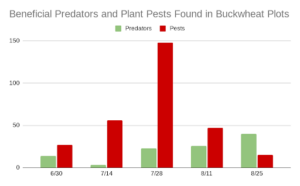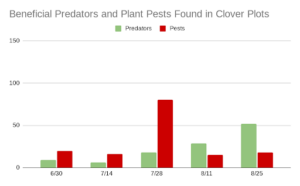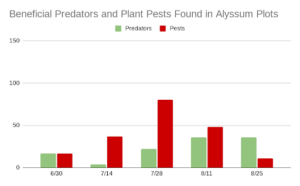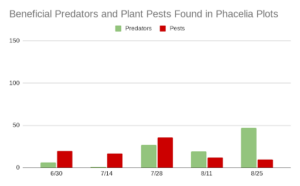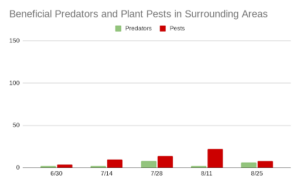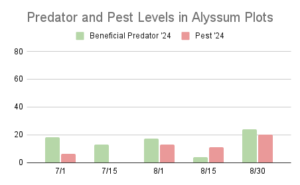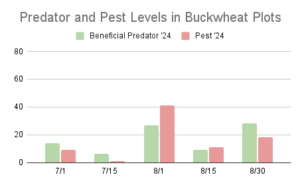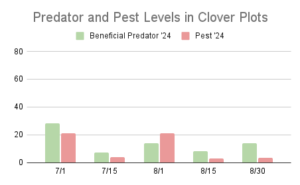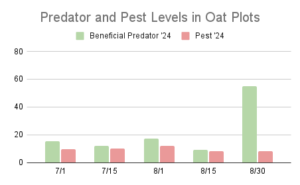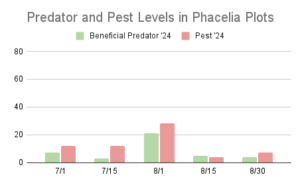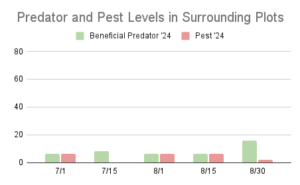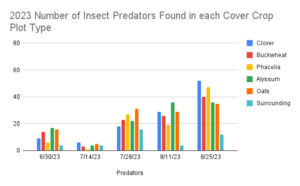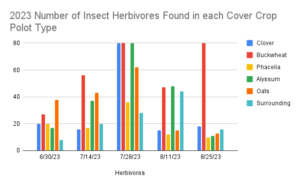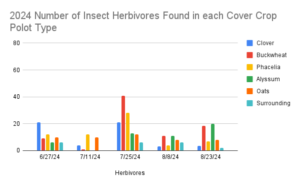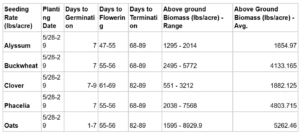Progress report for FW23-410
Project Information
The purpose of this project is to evaluate the efficacy of planting flowering cover crop plots to attract beneficial insect predators to nearby annual and perennial cut flower fields in Southcentral Alaska. Insect pests such as aphids, thrips, and tarnished plant bugs can damage important cut flower crops such as dahlias, stock, anemones and ranunculus. Controlling these pests using insecticides has the potential downsides of environmental and worker chemical exposure, equipment and labor costs, inconsistent and short-lived efficacy, and causing unintentional harm to populations of non-pest beneficial insects. We seek to provide growers with region-specific data about the efficacy of an alternative pest management tool: biological control. Specifically, we will be researching what types of flowering cover crops best attract beneficial insects that are predators to aphids, thrips, Lygus bugs, such as hover flies, big eyed bugs, damsel bugs, minute pirate bugs, wasps. While the use of cover crops, living mulches, and margin strips have been shown to be effective in attracting beneficial insect predators, many studies note the need for further research regarding how specific plant species, regionality, planting methods, or timing affects the efficacy of these practices. In order for these practices to be more widely adopted by growers in Alaska, they need to be demonstrated and proven locally.
Through an onsite demonstration day, agricultural conference presentation, and social media posts, the results of our project will give regional growers, agricultural professionals, and the general public information about the impact of including flowering cover crop plots on farms for the purposes of pest management.
Research Objective #1: Over two years of trials at Brown Dog Farm, determine the effect of four flowering cover crops–buckwheat, phacelia, red clover, alyssum–on attracting beneficial insect predators.
Research Objective #2: Over two years of trials at Brown Dog Farm, collect phenological data for four flowering cover crops in order to evaluate their suitability for incorporation on Southcentral Alaskan farms. Data collected will include germination date, flowering date, seed set and termination date, biomass production, and soil tests.
Education Objective #1: During years two and three of the funding period, provide at least 10 Alaskan flower and vegetable producers and agricultural service providers with reliable local data on the efficacy of using flowering cover crop plots to attract insect predators of major regional pests.
Education Objective #2: During years two and three of the funding period, provide at least 10 Alaskan flower and vegetable producers with reliable local data on technical aspects of utilizing flowering cover crop plots.
Education Objective #3: Throughout the funding period, share the potential benefits of using conservation biological control methods, including the use of flowering cover crop plots to attract beneficial insects, with local growers and the general public via social media.
The project timeline is described in the following Gantt Chart:
Cooperators
- - Technical Advisor
Research
Objective #1: Over two years of trials at Brown Dog Farm, determine the effect of four flowering cover crops–buckwheat, phacelia, red clover, alyssum–to attract beneficial insect predators.
This objective will be accomplished by planting subplots of each of the four cover crops–buckwheat, phacelia, red clover, alyssum–for two consecutive years at Brown Dog Farm. Varieties were selected for their reported ability to attract beneficial insects and because they are adapted to short growing seasons. Cover crop plots were planted during the last week of May (5/29/24 and 5/28/25), with two replicates of each of the four flowering cover crops planted along with a control subplots of oats, for a total of 10 subplots, divided between two larger plots. Oats were chosen as a control crop because its flowers are not insect pollinated and it is a commonly used cover crop by local farmers.
Each plot totaled 120 x 45 ft., and each subplot measured 24 ft. x 45 ft. The plots were located in two separate areas within Brown Dog Flower Farm's moose fence, each devoted to a two year cover crop fallow within the crop rotation plan. Each subplot was assigned a crop at random, and seeded at recommended rates using an Earthway broadcast seeder. Seeding dates and rates for each crop are demonstrated in the table located in the Objective #2 Results and Discussion section below. .
Insect sampling in cover crop plots began one month after seeding - June 26 in 2023 and June 27 in 2024. Six yellow sticky cards were placed at random locations within each subplot. Six control sticky cards were also placed in random locations of “spontaneous vegetation” surrounding the farm area, such as adjacent woodland and lawn areas. Sticky cards were left out for 4 days, then placed in bags in the freezer for data collection at a later point. A new set of sticky cards was placed in each subplot location at 2 week intervals until cover crop termination. Additional sweep samples were taken in each subplot and two control locations (woodland and lawn) at two week intervals beginning 7/13/23. Sweep samples were not collected in 2024 because 2023 samples did not produce measurable results (too few insects were collected in sweeps). Contents of sweep samples were deposited into a sealable bag, labeled, and frozen for later data collection.
Sticky cards and sweep samples were analyzed during winter months for presence of insect predators and common pests with the assistance of project technical advisor, Dennis Fielding, and findings are reported in the Objective #1 Research Results and Discussion section below.
Objective #2: Over two years of trials at Brown Dog Farm, collect phenological data for four flowering cover crops in order to evaluate their suitability for incorporation on Southcentral Alaskan farms. Data collected will include germination date, flowering date, seed set and termination date, biomass production, and soil tests.
The cover crop plots described above were also monitored throughout the 2023 and 2024 growing seasons for germination date, flowering date, seed set and termination, biomass production per square foot, and soil data. Soil samples were taken before planting and after crop termination in 2023 and after crop termination in 2024 in each subplot and sent to Brookside Laboratories for analysis of organic matter, pH, basic nutrients, and estimated available nitrogen (Test S001AN, Standard Soil with SMP/Sikora pH and Available N). Each subplot was observed weekly for the agronomic data listed in Objective #2, and key dates were recorded. Finally, before termination, the above ground biomass produced by each cover crop subplot was sampled by harvesting, drying, and weighing a 4 sq. ft. of cover crop selected at random.
Agronomic and soil sample data from both trial years are presented in the Research Results and Discussion section below.
Objective #1
Year 1 Results
Figures 1-6: Beneficial predatory and herbivorous pest insects collected in cover crop plots in 2023.
The above figures summarize the number of total beneficial predators and herbivore pests found in each type of cover crop and control plot at five collection dates throughout the 2023 season. The most common insect predators found in cover crop plots were parasitic wasps and hover flies, and the most commonly found insect pests were aphids and leaf hoppers. Generally, insect predator quantities increased throughout the summer, while insect pest quantities increased until the 7/28/23 sampling and decreased after. Predator counts ranged from near zero to over 50, while pest counts ranged from near zero to near 150 (a significant outlying count on 7/28 in buckwheat plots). The average number of predators counted per plot per week was 19.7, and the average number of pests was 36.6.
All cover crop plots appeared to attract more predators and pests that collection sites placed in surrounding areas. Between plots, the pattern of predator presence seems fairly consistent no matter the species of cover crop planted. The total sum of predators found in each separate type of cover crop plot ranged between 100 (phacelia) and 116 (oats). The greater difference between plots appeared to be the number of pest insects found in each. In this category, the buckwheat, clover, and alyssum plots were much higher than the oat and phacelia lots, with the relative difference between pest and predator numbers being the most favorable in phacelia plots.
Year 2 Results
The above figures summarize the number of total beneficial predators and herbivore pests found in each type of cover crop and control plot at five collection dates throughout the 2024 season. Once again, the most common beneficial predators found were hover flies and parasitic wasps and the most common herbivore pests found were leafhoppers and aphids. Predator counts ranged from zero to 55 beneficials insects collected per plot and pest counts ranged from zero to 41 insects collected per plot. The average number of predators counted per week per plot was 14, and the average number of pests counted per week per plot was 10.5. Trends in predator and pests collected varied by crop type. Pest collection levels generally increased throughout the season in alyssum plots, decreased in clover and surrounding vegetation plots, and peaked in the middle of the season in phacelia, oat, and buckwheat plots. Predator collection levels increased throughout the season in buckwheat, oat, alyssum and surrounding vegetation plots, decreased in clover plots, and peaked in the middle of the season in phacelia plots.
As in 2023, all cover crop plots in 2024 appeared to attract more predators and pests that collection sites placed in surrounding areas. The total sum of predators (all dates combined) found in each separate type of cover crop plot ranged between 40 (phacelia) and 108 (oats).
Discussion
Significantly, data from both years showed that cover crop plots generally attract more beneficials insects than areas of surrounding vegetation. In 2023, this trend was true for all crops tested during all sampling weeks except during the second week of July and for the phacelia plot during the last week of June (figure below). In 2024, buckwheat, alyssum, and oats attracted more beneficial predatory insects than surrounding areas on 6/27, 7/25, and 8/23. Clover attracted more beneficial predatory insects on 6/27 and 7/25, but not as many on 7/11, 8/8, and 8/23 (figure below). Phacelia only attracted more beneficial predatory insects during the week of 7/25 in 2024. Anomalies in weather and termination dates, discussed below, may have affected results for phacelia and alyssum plots during the last two sampling periods of 2024. Given these results, we feel confident drawing the conclusion that cover crop plots, especially those planted to buckwheat, alyssum, or oats, attract a higher number of beneficial insect predators than surrounding vegetation such as forest or lawn.
In addition to attracting more beneficial predatory insects, cover crop plots also often attracted more herbivorous insect pests, such as aphids and leaf hoppers, than areas of surrounding vegetation (figures below). While this trend was more variable over time, it was especially true in 2023. This observation complicates determining whether planting cover crop plots, and which type, has a net positive or negative impact on controlling insect pests by attracting beneficials.
Further complicating an analysis of whether planting flowering cover crop plots is beneficial for insect pest management is the result that no “flowering” cover crop (alyssum, buckwheat, clover, and phacelia) was more effective than the control cover crop, oats, even when the test crops were in flower (the last three weeks of samples). The hypothesis of this project was that the “flowering” crops would attract more beneficial predatory insects because those crops have pollen that can act as an alternative food resource for predators at early stages in their life cycles, as described in the SARE publication, “Managing Cover Crops Profitably.” We did not find this to be true in this experiment, with oat plots in many cases attracting a similar or greater number of beneficial predatory insects than any of the test plots in most weeks. In fact, oat plots attracted more total beneficial predatory insects than any other type of plot in both 2023 and 2024. We conclude that if cover crop plots are effective in attracting beneficial predatory insect, it may have more to do with habitat or prey resources provided by those plots rather than providing pollen or nectar as an attractive resource for those species.
On the other hand, beneficial insect predator numbers began to rise in all plots soon after cover crop flowering dates (roughly 7/25 - see data presented in Objective #2). One interesting line of inquiry may be examining whether this increase is due to seasonal ecological patterns in insect populations, or whether flowering cover crops made a difference for predator populations in certain areas. This pattern did not emerge as strongly in the surrounding area sample sites, which suggests that cover crops could be at play in attracting insect predators (and pests). The seasonality question could be tested by achieving earlier cover crop flowering via transplanting or use of shorter season crops. Given the results presented here, attaining flower stage in cover crop plots earlier could be beneficial for attracting predators earlier in the season.
One interesting difference between data collected in difference between data collected in 2023 and 2024 is that, generally, the total number of pests and beneficial predators collected each week was much lower in 2024 than in 2023. This can be easily visualized in the figures above, and is especially true of pest populations. We are unsure of the reason for this, and it contradicts a hypothesis that we made at the end of year 1 that healthier soil and cover crop plots the following year would lead to increased attraction of beneficial species. On the other hand, healthy plants may attract fewer herbivorous pests, which in turn could lead to a downturn in the predatory beneficial population as well due to lack of food supply. Either way, it is interesting to note that though our cover crop plots appeared much more vigorous and produced much greater levels of above ground biomass.
Another difference in results between 2023 and 2024 is that while beneficial insect predator counts gradually increased throughout the summer in 2023, in 2024 counts in most plots peaked on 7/25, dipped during the following collection period, and recovered slightly by 8/23. We have a variety of hypotheses for this. First, the week of the 8/8/24 data collection saw high amounts of rain. Our observations noted less insect activity in plots during this week, perhaps due to rain and colder temperatures. This may have affected the number of insects collected on sticky cards during this period. Second, alyssum and phacelia plots were terminated 8/4/24, before our final two data collection periods. Impact on the flowers and foliage in these plots may have affected insect populations during those periods. Our late-season 2024 results, however, do not change our conclusion that our test cover crop plots were no more effective in attracting beneficial insects than our control plots, and in fact add to a case for the benefit of flower farmers planting oats as a cover crop in the future rather than insect-pollinated crops. This dynamic is further discussed in the next paragraph.
The decision to terminate alyssum and phacelia plots early in 2024 was due to harm being caused to our surrounding farm crops by those plots. In late July 2024, we noticed that a high population of pollinators was leaving damaging amounts of pollen on blooming flowers across the farm. After consulting with our technical adviser, we determined that this was being caused by an overpopulation of flies, counted in this experiment as neither beneficials or pests, which were acting as pollinators. Our adviser told us that he had never seen such a high population, and together we determined that the issue was related to having provided a huge pollen source for this population to feed on. Flies were eating and gathering pollen from our cover crop plots, and when they landed on our nearby commercial crops, they would deposit or poop the pollen, causing damage to flower petals via bruising. Based on the color of the damaging pollen and poop, we determined that pollen was coming from phacelia and alyssum plots, and we chose to terminate those plots in order to save our crops.
In terms of overall sustainability of the cover cropping methods we tested in this experiment, the harmful effects of providing an excessive pollen food source for flies had the largest impact on our farm of any factor in this experiment. While our results leave us feeling uncertain about whether pollen-rich cover crops such as phacelia, clover, buckwheat and alyssum attract impactful levels of beneficial predatory insects, we know that that an alternative crop that is not insect pollinated, oats, is at least as effective in doing so. Because oats do not present us with the additional complication of creating a crop-damaging relationship with other species present on our farm, we intend to choose them as our primary cover crop moving forward. Future applications of flowering cover crops in systems such as ours that are intended to produce delicate may consider smaller or less dense flower cover crop plots that could attract beneficial insects without supporting over-populations of potentially harmful other species. For growers of other mixed crops, such as vegetables, this complex dynamic may not be an issue at all.
Questions that the results of the insect collection portion of this research left us with include the following: If pollen resources are not the most important factor in attracting beneficial predatory insects, what other cover crop and field management techniques could be used to attract those species? What role, for example, would integrated, undisturbed non-flowering cover crop plots play in providing insect habitat for pests and beneficials, and what type of population dynamic would this create? What management practices can be used to increase earlier predator emergence? How much do on-farm insect population dynamics have to do with individual species’ lifecycle? What type of research and sampling methods would we use to learn more about these dynamics? How do we as farmers maximize the farm and ecosystem benefits of providing habitat/food plots for insect predators while also mitigating the potential downsides, known and unknown?
Objective #2
The following tables and links describe agronomic data collected in each cover crop plot during the 2023 and 2024 seasons.
Table 1. Agronomic data from 2023 growing season
In 2023, plots showed remarkable uniformity in days to germination and to flower, except for clover, which germinated in 9 days instead of 7 and flowered in 69 days instead of 55 (Table 1). All plots were terminated at 89 days after planting, when flowers were beginning to turn to seed but no seed had matured to viability. Of the cover crops grown, buckwheat produced the greatest average biomass per acre (2494 lbs/acre), and clover produced the least (551 lbs/acre).
Table 2. Agronomic data from 2024 growing season
In 2024, cover crop plots were planted one day earlier in May, and oats germinated in just one day. All other crops took seven days to germinate. We attribute the difference in germination period between 2023 and 2024 to variance in environmental factors. Days to flowering for crops in 2024 remained similar to 2023 for three crops: buckwheat, phacelia, and oats. Alyssum flowered in just 47 days (compared to 55 in 2023) and clover flowered in 61 (compared to 69 in 2023). While all crops in 2023 were terminated after 89 days, alyssum, buckwheat and phacelia were terminated after 68 days in 2024 due to an overproduction of pollen which was damaging nearby crops (see Objective #1 discussion above for explanation). Clover and oats were terminated after 82 days in 2023.
A large difference in our 2023 and 2024 data can be seen in results for aboveground biomass produced by all crops. In 2023, aboveground biomass ranged between 551.7 - 2494.63 lbs/acre, whereas in 2024 aboveground biomass produced by crops ranged between 2014.65 - 8929.8 lbs/acre. The cause of this variance is a difference in fertilization of plots. In 2023 we did not fertilize cover crop plots before seeding, which followed our normal growing practices. However, we realized in Year 1 that the transition from previously raw land to farm field affected the growth of our cover crop plots; applying fertilizer in 2024 helped us gain an understanding of how cover crops produced in more favorable conditions. 2024 applications of organic fertilizer followed AK Cooperative Extension recommendations. The following table presents combined data from 2023 and 2024 cover crop plots that demonstrate ranges and averages for various data categories.
Table 3. Agronomic data on 5 cover crop species grown in 2023 and 2024 on Brown Dog Flower Farm.
Soil Tests
Soil test measurements remained relatively stable in all plots over the two-year trial period for pH, organic matter, and most macro and micro-nutrient levels. All plots saw a major increase in estimated releasable N between the Spring and Fall tests in 2023, however, no particular crop saw a significant gain over another, and estimated N release stabilized between 2023 and 2024. Phosphorus levels increased significantly in all plots between 2023 and 2024, which can be attributed to fertilizer application in the spring of 2024. Soil test data can be viewed via the links below, using the typed keys to identify which plots on the tests were planted to which cover crops on a given year.
2023 Soil Test Plot Key
Plot 1 = Crimson Clover
Plot 2 = Oats
Plot 3 = Buckwheat
Plot 4 = Phacelia
Plot 5 =Sweet Alyssum
Plot 6 = Buckwheat
Plot 7 = Sweet Alyssum
Plot 8 = Oats
Plot 9 = Clover
Plot 10 = Phacelia
2024 Soil Test Plot Key:
Zone 1 = Sweet Alyssum
Zone 2 = Oats
Zone 3 = Buckwheat
Zone 4 = Clover
Zone 5 = Phacelia
Zone 6 = Buckwheat
Zone 7 = Phacelia
Zone 8 = Oats
Zone 9 = Sweet Alyssum
Zone 10 = Clover
Research outcomes
The research activities of this project yielded the following outcomes and recommendations:
- Flowering cover crop plots attract more beneficial predatory insects than “natural” vegetation surrounding the farm such as forest and yard.
- Farmers can plant flowering cover crop plots on their farm in order to attract beneficial predatory insects.
- The impact of planting any type of cover crop on attracting populations of beneficial predatory insects is more important than the specific type of cover crop planted.
- Planting flowering cover crop plots can have unintended impacts on local agroecosystems, and growers should choose their crops and cropped areas carefully, trialing a particular method on a small part of their farm before applying a practice broadly.
- Growers should choose to plant cover crops that are compatible with their growing system and goals.
- Example 1. Because we know that high availability of pollen on our farm will lead to damage to our commercial crops, we will choose cover crop species that do not have high levels of insect-available pollen and/or terminate cover crops before they flower.
- Example 2. One challenge we have with cover cropping is incorporating the large amount of biomass the practice creates back into the soil. Our farm operates without any machinery large enough to do this mechanically. For this reason, we might choose to select a cover crop that does not produce a high level of biomass, such as sweet alyssum or clover.
- Data specific to Alaska about the days to germination, flowering, and total above ground biomass for the cover crops alyssum, buckwheat, clover, phacelia, and oats can be found in the results section of this report.
Recommendations for future studies:
- A study that examines the presence of beneficial predatory insects within commercial crop areas, not just in cover crop areas nearby.
- Controlled studies determining the effect of increased local beneficial predatory insect populations on herbivorous insect damage to crops.
- Studies that link growing practices such as cover cropping, alley cropping, tillage, timed mowing, etc. to local insect life cycles and answer the question: what growing practices support on-farm habitat for beneficial insects?
Education and Outreach
Participation summary:
Education Objective #1: During years two and three of the funding period, provide at least 10 Alaskan flower and vegetable producers and agricultural service providers with reliable local data on the efficacy of using flowering cover crop plots to attract insect predators of major regional pests.
&
Education Objective #2: During years two and three of the funding period, provide at least 10 Alaskan flower and vegetable producers with reliable local data on technical aspects of utilizing flowering cover crop plots.
Education Objectives #1 & #2 were worked towards on all years of the project, beginning in Year 1 when we hosted a beneficial predatory insect ID day at our farm with our technical advisor. Three local farmers attended and gained knowledge about beneficial insects present in our cover crop plots and how to identify them.
During Year 2 of the project, we accomplished this objective by hosting a field day and tour of the project and our farm in order to demonstrate the methods of cover cropping we used. During the field day, we shared methods for planting and growing cover crops, challenges and successes in the cover crop plots, beneficial insect identification, observations, and early results of the project. The field day was attended by 6 growers and one agricultural service provider in addition to our technical adviser.
Additionally, initial results and observations of the project, along with general information about the benefits of using flowering cover crops, were shared with our farm in November 2024 (Year 2) at the UAF/Western SARE Alaska Food Conference in Fairbanks, AK. The presentation was attended by over 20 individuals, approximately 6 of whom were farmers themselves.
Finally, we will devote Year 3 to sharing our Research outcomes and recommendations with local farmers, and gaining feedback on if they find this information useful and plan to implement any of the practices we have researched.
Education Objective #3: Throughout the funding period, share the potential benefits of using conservation biological control methods, including the use of flowering cover crop plots to attract beneficial insects, with local growers and the general public via social media.
Ongoing information about this project will be shared on our social media (Instagram) page. Each year, we will make four posts on topics directly related to the project on topics including project purpose, methods, potential benefits of cover cropping, identification of insect pests and predators, and potential benefits of conservation biological control methods. We expect at least 60 individuals to engage with each post, for a total of 720 engagements over 3 years.
During Year 1 we posted four project updates, and during Year 2 we posted two project updates, the results of which are reported below. Social media outreach, including specific research outcomes, will continue during Year 3.
Education Objectives #1 & #2: Having begun to share information about our cover crop with local farmers during Year 2 of the project, we plan to share specific outcomes and recommendations based on our research during Year 3. This phase of the education aspect of our project will include distributing the Western Region Sustainable Agriculture Research & Education Program Outreach Survey in order to understand whether growers we've been in contact with learned from our research, and whether they plan to adopt any of the practices researched. The results of this survey will be shared at the end of Year 3 of this project.
Education Objective #3: Throughout the funding period, share the potential benefits of using conservation biological control methods, including the use of flowering cover crop plots to attract beneficial insects, with local growers and the general public via social media.
During Year 1 we posted project updates on the following dates and topics:
March 13, 2023: Project plans and overview, benefits of cover cropping and beneficial insects for flower growers. 123 Instagram engagements, 19 Facebook engagements.
August 14, 2023: Benefits of attracting insect predators to the farm with cover crops, species of garden pests we are hoping to thwart, pictures of flowering cover crop plots. 53 Instagram engagements, 9 Facebook engagements.
October 15, 2023: Benefits of including cover crop in farm plans, project overview, the use of cover crops to attract beneficial species. 53 Instagram engagements, 14 Facebook engagements.
January 27, 2024: The process of identifying beneficial and pest insects on sample sticky cards (with pictures). Names of most common predators found in our samples: parasitic wasps, hover flies, a damsel bug. 56 Instagram engagements, 10 Facebook engagements.
During Year 2 we posted project updates on the following dates and topics:
August 22, 2024: Goals of the project and summary of observations to date. 73 Instagram engagements.
September 10, 2024: Sharing of Western SARE video discussing design and results of project. 44 Instagram engagements.
Education and Outreach Outcomes
Education and Outreach outcomes will be gained and shared after the Year 3 educational phase of this project.
